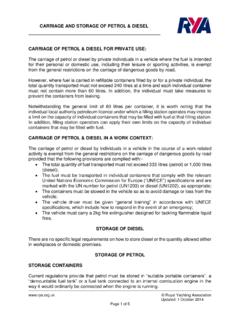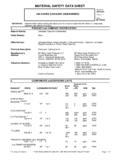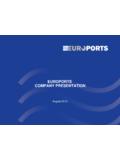Transcription of SPECIFICATION DATA SHEET Unleaded Petrol 95 Octane BS …
1 FUEL OILS SPECIFICATION data SHEET Revision Date 21/01/15 Unleaded Petrol 95 Octane BS EN 228 Sulphur-free Petrol 10 ppm maximum sulphur (PU10) Unleaded Petrol is suitable for use in all Petrol (spark ignition) engine vehicles where the vehicle manufacturer recommends the use of an Unleaded Petrol with a Research Octane Number of 95 (RON 95). Unleaded Petrol is not suitable for use in all vehicles and in cases of doubt the should always be consulted prior to use. Ultra Low Sulphur Petrol exceeds the latest requirements of the relevant British and European Standard specifications BS EN 228 and contains a detergent additive to help keep carburetors, fuel injectors and inlet valves clean, maintaining drivability and performance. MINIMUM MAXIMUM TYPICAL Appearance Clear & Bright Clear & Bright Water and Suspended Matter None Visible None Visible Density @ 15 o C, kg/m 720 775 724 Copper Corrosion, 3 hours @ 50 C - 1 1 Sulphur content, mg/kg - Existent Gum (solvent washed) mg/100ml - 5 1 Oxidation stability, minutes 360 - >360 Lead Content, g/l - < Benzene Content % volume - Research Octane Number (RON) - Motor Octane Number 85 - Distillation Characteristics MINIMUM MAXIMUM TYPICAL % Volume Evaporated @ 70oC 20 48 32 % Volume Evaporated @ 100oC 46 71 56 % Volume Evaporated @ 180oC 75 91 Final Boiling Point oC - 210 185 Residue % Volume - 2 1 Vapour Pressure, kPa Ethanol (%V/V Summer 45 70 Winter 70 100 73 FUEL OILS SPECIFICATION data SHEET Revision Date 21/01/15 Petrol Safety Information 1.)
2 CHEMICAL PRODUCT and COMPANY INFORMATION (rev. Jan-2003) Fuel Oils Burnett Rd Darent Industrial Park Slade Green Erith, Kent. DA8 2LG 2. COMPOSITION and INFORMATION ON INGREDIENTS Complex mixture of hydrocarbons in the C4-C11 range. CAS No 86290-81-5. EINECS No 289-220-8. The main components are paraffinic, naphthenic and aromatic hydrocarbons but catalytically and thermal cracked constituents from refinery processes may be present. May also contain up to 5% bio-ethanol. Additives : Multifunctional gasoline additives xi, R36/37/38,43 <1% Organic Potassium Salt (LRP only) xi, R36/38 <400ppm Oxygenates up to the maximum permitted by BSEN228 Symbol/R & S Phrases Concentration : Benzene T, R45 < 1% n-Hexane Xn, R11, 48/20 < 2% Methyl-tert-butyl ether (MTBE) - < 10% Bio-ethanol F, R11 5% 3. HAZARDS IDENTIFICATION EMERGENCY OVERVIEW Extremely flammable. Explosive mixtures may form at ambient temperatures. May cause irritation in contact with eyes and skin. Harmful if swallowed.
3 Aspiration into the lungs caused by vomiting is harmful and can be fatal. Contains benzene: prolonged or repeated exposure to benzene may cause anaemia and other blood diseases including leukemia. Classified as a category 2 carcinogen. Toxic to aquatic organisms, may cause long term adverse effects in the aquatic environment. EYES Likely to cause minor irritation if splashed into the eye with short-term redness and stinging Immediately wash with fresh water for at least 15 minutes. Obtain medical advice if pain or redness develops. SKIN May cause irritation on brief or occasional contact; prolonged, repeated and heavy direct contact with the skin over a long period of time can cause defatting of the skin, erythema, dermatitis, oil acne. Remove contaminated clothing as soon as possible. Wash exposed skin thoroughly with soap and water. If irritation persists, seek medical attention. INGESTION Likely to cause nausea and diarrhoea if small amounts are swallowed; larger amounts may effect the central nervous system.
4 Signs and symptoms of nervous system effects may include one or more of the following; headaches, dizziness, loss of appetite, weakness and loss of concentration. The product can be harmful due to aspiration of liquid into the lungs following ingestion which may cause chemical pneumonitis and can be fatal. If this material is swallowed, DO NOT INDUCE VOMITING. If unconscious, place in recovery position and protect airway. Seek immediate medical attention. FUEL OILS SPECIFICATION data SHEET Revision Date 21/01/15 INHALATION No hazards associated in normal operations. Inhalation of vapours or fumes may cause headaches, nausea, drowsiness and irritation to the breathing passages and lungs with possible effects to the central nervous system. As gasoline contains benzene which is a know carcinogen continuous exposure to high levels of vapours may be toxic and in extreme cases may lead to leukemia. If over exposure occurs, remove to fresh air. Administer artificial respiration if breathing stops.
5 Seek immediate medical attention. WARNING: The burning of any hydrocarbon as a fuel in an area without adequate ventilation may result in hazardous levels of combustion products, including carbon monoxide, and inadequate oxygen levels, which may cause unconsciousness, suffocation, and death. CHRONIC EFFECTS and CARCINOGENICITY Similar products have produced skin cancer and systemic toxicity in laboratory animals following repeated applications. The significance of these results to human exposures has not been determined see Section 11 Toxicological Information. MEDICAL CONDITIONS AGGRAVATED BY EXPOSURE Irritation from skin exposure may aggravate existing open wounds, skin disorders, and dermatitis (rash). 4. FIRST AID MEASURES EYES In case of contact with eyes, immediately flush with clean, low-pressure water for at least 15 min. Hold eyelids open to ensure adequate flushing. Seek medical attention. SKIN Remove contaminated clothing. Wash contaminated areas thoroughly with soap and water or with waterless hand cleanser.
6 Obtain medical attention if irritation or redness develops. INGESTION DO NOT INDUCE VOMITING. Do not give liquids. Obtain immediate medical attention. If spontaneous vomiting occurs, lean victim forward to reduce the risk of aspiration. Monitor for breathing difficulties. Small amounts of material which enter the mouth should be rinsed out until the taste is dissipated. INHALATION Remove person to fresh air. If person is not breathing, provide artificial respiration. If necessary, provide additional oxygen once breathing is restored if trained to do so. Seek medical attention immediately. 5. FIRE FIGHTING MEASURES FLAMMABLE PROPERTIES: FLASH POINT: 100 oF (38 oC) minimum PMCC AUTOIGNITION POINT: 494 oF (257 oC) LOWER EXPLOSIVE LIMIT (%): UPPER EXPLOSIVE LIMIT (%): FIRE AND EXPLOSION HAZARDS OSHA and NFPA Class 2 COMBUSTIBLE LIQUID Vapours may be ignited rapidly when exposed to heat, spark, open flame or other source of ignition. When mixed with air and exposed to an ignition source, flammable vapors can burn in the open or explode in confined spaces.
7 Being heavier than air, vapours may travel long FUEL OILS SPECIFICATION data SHEET Revision Date 21/01/15 distances to an ignition source and flash back. Runoff to sewer may cause fire or explosion hazard. EXTINGUISHING MEDIA SMALL FIRES: Any extinguisher suitable for Class B fires, dry chemical, CO2, water spray, fire fighting foam, or Halon. LARGE FIRES: Water spray, fog or fire fighting foam. Water may be ineffective for fighting the fire, but may be used to cool fire-exposed containers. FIRE FIGHTING INSTRUCTIONS Small fires in the incipient (beginning) stage may typically be extinguished using handheld portable fire extinguishers and other fire fighting equipment. Firefighting activities that may result in potential exposure to high heat, smoke or toxic by-products of combustion should require NIOSH/MSHA- approved pressure-demand self-contained breathing apparatus with full face piece and full protective clothing. Isolate area around container involved in fire.
8 Cool tanks, shells, and containers exposed to fire and excessive heat with water. For massive fires the use of unmanned hose holders or monitor nozzles may be advantageous to further minimize personnel exposure. Major fires may require withdrawal, allowing the tank to burn. Large storage tank fires typically require specially trained personnel and equipment to extinguish the fire, often including the need for properly applied fire fighting foam. 6. ACCIDENTAL RELEASE MEASURES ACTIVATE FACILITY S SPILL CONTINGENCY OR EMERGENCY RESPONSE PLAN. Evacuate non essential personnel and remove or secure all ignition sources. Consider wind direction; stay upwind and uphill, if possible. Evaluate the direction of product travel, diking, sewers, etc. to confirm spill areas. Spills may infiltrate subsurface soil and groundwater; professional assistance may be necessary to determine the extent of subsurface impact. Carefully contain and stop the source of the spill, if safe to do so.
9 Protect bodies of water by diking, absorbents, or absorbent boom, if possible. Do not flush down sewer or drainage systems, unless system is designed and permitted to handle such material. The use of fire fighting foam may be useful in certain situations to reduce vapours. The proper use of water spray may effectively disperse product vapors or the liquid itself, preventing contact with ignition sources or areas/equipment that require protection. Take up with sand or other oil absorbing materials. Carefully shovel, scoop or sweep up into a waste container for reclamation or disposal. Response and clean-up crews must be properly trained and must utilize proper protective equipment (see Section 8). 7. HANDLING and STORAGE HANDLING PRECAUTIONS Handle as a combustible liquid. Keep away from heat, sparks, excessive temperatures and open flame! No smoking or open flame in storage, use or handling areas. Bond and ground containers during product transfer to reduce the possibility of static-initiated fire or explosion.
10 Special slow load procedures for "switch loading" must be followed to avoid the static ignition hazard that can exist when this product is loaded into tanks previously containing low flash point products STORAGE PRECAUTIONS Keep containers closed and clearly labeled. Use approved vented storage containers. Empty product containers or vessels may contain explosive vapours. Do not pressurize, cut, heat, weld or expose such containers to sources of ignition. Store in a well-ventilated area. Avoid storage near incompatible materials. The cleaning of tanks previously containing this product should follow recommended practice "Cleaning Mobile Tanks In Flammable and Combustible Liquid Service" and "Cleaning Petroleum Storage Tanks." FUEL OILS SPECIFICATION data SHEET Revision Date 21/01/15 WORK/HYGIENIC PRACTICES Emergency eye wash capability should be available in the near proximity to operations presenting a potential splash exposure. Use good personal hygiene practices.








